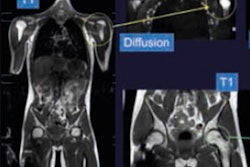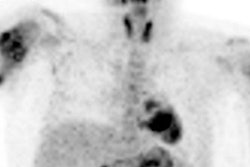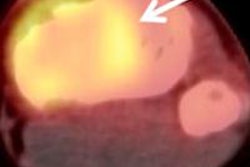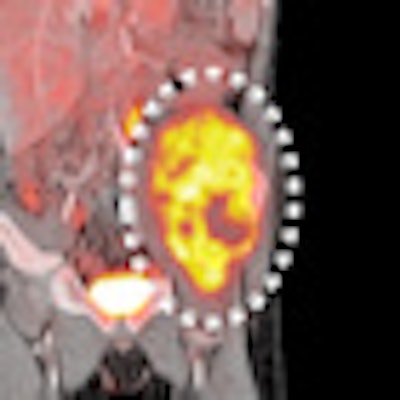
PET/CT could be an option for evaluating children with osteosarcomas, but not for those with Ewing's or soft-tissue sarcoma due to lower levels of FDG uptake in these patients, a new study indicates. The findings differ from results in adults, which have shown similar FDG uptake levels among the sarcoma types.
Previous studies have found that in adults, 90% of soft-tissue and bone sarcomas have strong glycolytic phenotypes, meaning these tumors have high glucose avidity and, thus, are good candidates for evaluation with FDG-based PET/CT. What's more, adults show little difference in glucose avidity between osteosarcoma and Ewing's sarcoma.
But can these results be extrapolated to children? Researchers from the University of California, Los Angeles (UCLA) wanted to find out, and they presented their findings at this month's SNM meeting in Salt Lake City.
Glycolytic phenotypes
Knowing the glycolytic phenotype of cancers is important to determine whether PET imaging can be used for detecting, staging, and monitoring the disease, according to lead study author Franziska Walter, MD. Walter and colleagues at UCLA wanted to determine the glycolytic phenotype of sarcomas in pediatric patients, and also whether there are differences in the glycolytic phenotype of pediatric sarcomas compared to adult patients.
Walter, from UCLA's molecular and medical pharmacology department, noted that bone sarcomas account for 6% of all childhood malignancies, overall, with 650 to 700 newly diagnosed cases in the U.S. annually. Soft-tissue sarcomas account for approximately 7.4% of childhood malignancies, with 850 to 900 newly diagnosed cases in the U.S. each year.
The retrospective study enrolled 30 patients who were imaged between January 2005 and March 2010. There were 23 males and seven females, with a mean age of 13 years. Twenty patients were diagnosed with bone sarcoma and 10 patients had soft-tissue sarcomas.
Twenty-three patients (75%) received an FDG-PET/CT study (Biograph Duo, Biograph 64, Siemens Healthcare, Malvern, PA), while seven patients were imaged with a whole-body PET scanner (ECAT Exact HR+, Siemens). Patients received 0.15 mCi of FDG per kg of body weight, with a minimal uptake period of 50 minutes.
Tumor FDG uptake was determined by measuring the maximum standardized uptake value (SUVmax), with researchers comparing SUVmax levels on FDG-PET/CT and whole-body PET. Tumor size was measured from CT images of all patients who underwent FDG-PET/CT imaging.
The researchers also quantified tumor FDG uptake by SUVmax and tumor-to-liver ratios (SUVmaxT/SUVmeanL) for better comparability between PET/CT and PET.
Newly diagnosed tumors
Among the 20 patients with bone sarcomas, eight of the 20 cases were Ewing's sarcoma and 12 were osteosarcoma. Of the 10 patients with soft-tissue sarcomas, nine cases were high-grade sarcomas and one case was a low-grade sarcoma. The researchers also found newly diagnosed tumors in 27 patients, while three patients presented with recurrent disease.
Nineteen of the 30 primary tumors were located in the extremities, eight tumors were in the abdomen or pelvis, two tumors were in the head, and one tumor was in the trunk. Tumor diameter ranged from 0.6 to 29 cm, with a mean value of 9.6 cm.
The researchers measured and compared SUVmax in bone sarcoma and soft-tissue sarcoma cases, and the group found the 12 osteosarcoma cases to have generally the highest SUVmax readings among all cancers, with a mean of 10.1 and ranging from 4 to 21. The eight Ewing's sarcoma cases had a much lower SUVmax level, with a mean of 4 and a range from 1 to 9.
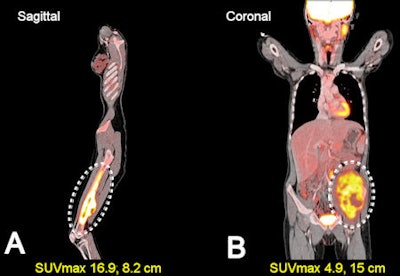 |
| Image A shows a 14-year-old patient with an osteosarcoma in the distal femur. The tumor exhibited a high SUVmax of 16.9. Image B is a coronal view of a 10-year-old with Ewing's sarcoma of the left hemipelvis with a lower SUVmax of 4.9. FDG uptake was heterogeneous in both tumors. The areas of low FDG uptake represent tumor necrosis. Images courtesy of Fran Franziska Walter, MD. |
Among the soft-tissue sarcomas, the mean SUVmax was 4.4, with nine cases between 1 and 6. The highest SUVmax among all 30 tumors was the one case of angiosarcoma, which had an SUVmax of 24.
Variability correction
To account for possible differences in equipment, the researchers normalized lesion uptake to liver uptake, Walter said. Soft-tissue sarcomas had an average tumor-to-liver ratio of 2.3. The whole group of 20 bone sarcomas had a tumor-to-liver ratio of 4.3. "When we divide the group of bone sarcomas into Ewing's sarcomas and osteosarcomas, we see that the high ratio [5.1] is due to higher SUVs of osteosarcomas," she added.
In conclusion, the study determined that all sarcomas were visualized by FDG-PET and by FDG-PET/CT in the pediatric patient population, with osteosarcoma having a stronger glycolytic phenotype than both Ewing's sarcoma and soft-tissue sarcoma.
"These results differ from our data in adult patients that showed no significant difference in SUVmax between Ewing's sarcoma and osteosarcoma," Walter said. "The strong glycolytic phenotype of pediatric osteosarcoma suggests that treatment monitoring with FDG-PET/CT is feasible."
She added, however, that the relatively low FDG uptake in some Ewing's and soft-tissue sarcoma cases might not support treatment monitoring with PET. "We suggest that further investigation with a bigger sample size is needed," she said.
By Wayne Forrest
AuntMinnie.com staff writer
June 25, 2010
Related Reading
Shorter PET/CT acquisition times suitable for many kids, June 17, 2010
FDG-PET/CT helps track pediatric bone and soft-tissue tumors, June 16, 2009
Soft-tissue sarcoma outcomes vary widely by race, ethnicity, January 25, 2008
PET/CT shows great sensitivity, concordance with soft-tissue sarcoma, August 23, 2007
Copyright © 2010 AuntMinnie.com




